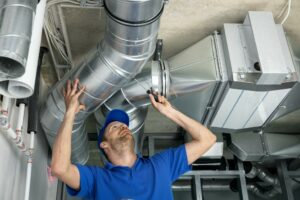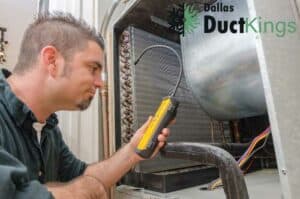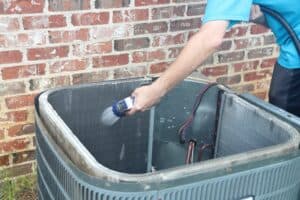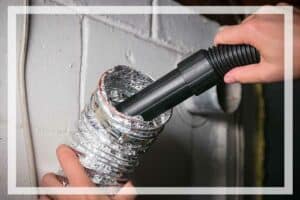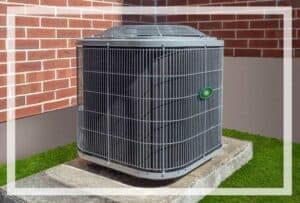A commercial HVAC system is a lot more complicated than a domestic one in all aspects.
Not only is it a more complex system, but it also typically involves several stakeholders to maintain and manage.
These interested parties are such as the owner of the building, the facility manager, and the tenants, who may be rather many if it is a large building.
Stakeholders in a commercial building have to have a common approach to keep the HVAC system functioning right.
A poorly performing HVAC system can lead to losses of time and income for tenants and owners of commercial buildings.
One important thing you should do on an annual base is the air duct cleaning commercial process, this will help protect the unit and also protect the employees in your business.
Providing HVAC Systems Solutions For Over A Decade
If you own HVAC systems, we would like to help you keep your system functioning correctly.
A properly functioning HVAC in a commercial building prioritizes the comfort of employees, clients, and other occupants in an office building.
Let our experts handle your issues if you struggle to keep the HVAC system in your building in good shape.
If the climate in your commercial building is a thorny issue that interrupts business for your tenants, talk to us at Duct Kings of Dallas about your problem.
You may also just want to bring some professionalism to managing the HVAC system in your office buildings. Try our experts and get an assessment of the needs of your commercial system.
We pride ourselves on our state-of-the-art technology to give excellent results, whatever your system may need. Our technicians are fully trained and efficient. Call us at (214) 624-6232 and schedule an inspection with our friendly staff.
This Commercial HVAC guide is meant to help you understand the air conditioning system in your building better.
We at Duct Kings of Dallas aim to arm you with information, so you do not fumble in confusion anymore, unaware of what you are dealing with.
Here is what you need to know about a commercial HVAC system.
What Is A HVAC System?
HVAC is an abbreviation for Heating, Ventilation, and Air Conditioning. Commercial heating and air conditioning systems serve the same purpose as domestic ones.
They are meant to keep the temperatures at 72 degrees F and humidity at 40 -60%.
Commercial HVAC systems are found almost everywhere, in residential and commercial buildings.
You can find them in standalone family homes and submarines, where they regulate indoor climate and make enclosed spaces safe and comfortable for occupants.
An HVAC system works in the following manner: Ventilation is when they replace and exchange the air in a space.
The system uses outdoor air to improve the air’s freshness in a confined space. These systems freshen the air by cleaning it and cooling it.
They remove odors, carbon dioxide, airborne bacteria, heat, dust, and other contaminants trapped indoors.
HVAC systems in small offices and commercial buildings use fans to bring in air from the outdoors. The fresh air from outside is mixed with indoor air and allowed to flow through filters.
When the mixed air flows through filters, contaminated air is expelled from the building, leaving fresh, clean air.
Freshening the indoor air during ventilation increases oxygen in the air and keeps carbon dioxide at lower than 1000 molecules per million.
Ventilation is the most important aspect of an HVAC operation. An effective HVAC system keeps air in a building fresh and uncontaminated.
Occupants of a building that is well-ventilated report fewer allergic reactions. Wherever an HVAC system is found, it serves three main purposes: heat, ventilate and condition the air in the enclosed space.
When the air in a commercial building is warm, it requires cooling and heating when it is cold. An HVAC system heats air by burning fuel. These fuels are such as electricity, oil, and gas.
Cooling the air in an industrial building is achieved by extracting it and passing it through water-cooled systems or refrigerants. This process eliminates any excess humidity as well.
From the preceding, it looks like an HVAC system does a complex job. But you do not need to see it that way. Next, we look at how it performs its purpose.
How Does A Commercial HVAC System Serve Its Purpose?
An HVAC system comprises several parts that function together to ensure the system delivers efficiently.
We look at these parts to see how they work together to provide a perfectly working whole.
Three elements are necessary for a commercial HVAC system that helps you control the climate of a building. These are the following,
- Cool or hot air
- A method of distribution and,
- Controls
A thermostat regulates hot and cold air, and all the air flows through the same air ducts in a commercial building. It is the source of the air that differs.
Cool or Hot Air
When you heat in a commercial HVAC system, cold air is transferred for warming into the heat exchanger, which has combustion gas created by the burners.
Outdoor heat is transferred indoors by heat pumps in some instances. Air conditioners work in reverse, though, by transferring indoor heat outdoors.
Some commercial buildings do not use burning fuels to warm air but use water boiler systems.
Pipes are installed on ceilings, floors, and walls, and the hot water is passed through them, warming the air within the building.
Distribution
The distribution system works on the principle that warm air rises and cool air falls. Mechanical systems circulate a building’s air via ventilation.
The temperature of the air is, in some instances, altered a lot depending on the need – if it is being warmed or cooled. While the preceding is happening, there is a lot of removal and introduction of air into the system.
Controls
Controls in commercial HVAC systems can be programmable and simple thermostats that send cooling and heating queues throughout the day, as happens in residential HVAC systems.
Another control that commercial buildings have is a lot more complex and is referred to as direct digital controls.
These more advanced controls are necessary for more reliability and energy efficiency. A central computer automates and monitors temperature schedules and lighting operations using sensors.
Both controls allow users to implement temperature setbacks and save up to 20% on energy.
Temperature setbacks refer to when the building is empty of people, and no cooling or heating is needed, such as at night when the building is empty.
- More on Commercial HVAC Direct Digital Control Thermostat (DDC)
This is a sophisticated, more flexible, and expensive option. It features a main workstation.
Staff can adjust and respond to settings from the workstation. Users can carry out maintenance, troubleshoot issues, and get performance updates.
Types of HVAC Systems For Commercial Buildings
There are three main categories of HVAC systems for commercial buildings in the United States. These are the following,
Individual HVAC
These kinds are considered decentralized systems. They perform their function of heating, ventilation, and cooling by having multiple individual units in different building locations.
These are not preferred for larger commercial buildings despite their easy use. AC units for offices or rooms and rooftop units are examples of individual HVAC systems.
Packaged
These have several parts together as one system. These parts are a fan coil, evaporator, heat pump, and air conditioner.
The package includes a thermostat that regulates temperatures, thereby controlling the system.
Other optional pieces, such as ventilators, cleaners, and air quality improvers, are also likely to be included. They are ideal for commercial buildings that have little space.
Centralized
This indoor unit supplies the HVAC needs of an entire commercial building. It is typically located in one zone or area of the building.
The system relies on water as the cooling medium and has plenty of ductwork for air distribution.
They are easy to control and use and can handle much more load than the other categories. The downside is that they are complex to operate and maintain.
Detailed Look At Systems Categories
Split Systems
These resemble residential units in that they are connected to the building’s ductwork. Each area under a multi split system is controlled via a thermostat or DDC.
The multi split system works for smaller commercial buildings, such as restaurants or small offices and stores.
The cons: a different HVAC indoor unit might be necessary for each enclosure you want to control, which leads to cluttering the space around the building or the rooftop.
Zoning helps to control the different spaces, but multi split system is expensive.
VRF Systems
These systems are rather complex and not too common in the United States. They do not have ducts and rely on heat recovery systems use or heat pumps.
These heating systems send the refrigerant from compressors and condensers housed in a central outdoor unit.
They offer better thermal control as the rate at which each zone gets refrigerant determines the area’s temperature.
This system is quiet, occupies very little space, is easy to install, and requires no ductwork.
All the indoor parts of the VRF system can fit in a building elevator. These systems are about 30% more efficient than those with ducts.
This efficiency is because no energy is lost through the ductwork, and the compressors, which run at varying speeds, are more accurate in adjusting temperatures.
This system is used in commercial buildings larger than the ones where split systems are used.
The CONs: they are costly, and a backup condenser is necessary in case of a malfunction
Rooftop HVAC (RTU)
This unit is a Package unit that is placed on the roof of a commercial building. These systems are installed on buildings no more than ten floors high.
Weather-resistant housing protects the main components of the RTU. It comprises of blower, evaporator, condenser, and compressor.
This unit is assembled at the factory. It functions primarily by altering air and then circulating it through the ducts.
It comprises an air hood that sucks in outside air for conditioning and dampers that control airflow and push it through to the filter.
The filter drives the air to the coils responsible for heating or cooling the air. The fan that sucks in the air then blows it to the duct system, which carries it where it should go.
An RTU combines inside and outside air to keep carbon dioxide levels safe and prevent overworking the system during extreme weather days.
So what are the Pros of an RTU?
- It comes from the factory completely assembled
- Cost-effective
- Very adaptable and simple
- You can purchase several of them and zone each, so each unit takes care of one building area.
- New models are more efficient
- Quiet
- Easily installed
- Saves space
- The location where you install it is more secure
- They are popular
Cons of an RTU
- Not as long-lasting as other types
- Occupies ample space on the roof.
- Older models can use up ample energy, which raises utility bills
- It requires regular maintenance
Do you still feel confused about the ideal commercial HVAC for your needs? We can help you with that.
Talk to us at The Duct Kings of Dallas for an assessment of your needs or get a quote. Here is our number: (214) 624- 6232
What Are The Differences Between Commercial and Residential HVAC?
There are some major differences between commercial and residential HVAC, other than what type of building you put each on. Here are the main differences between the two types of HVAC systems.
Size of the system
Size is the primary difference between commercial and residential HVAC systems. Residential systems are smaller because they are typically used in households, while commercial HVAC is employed in larger buildings.
Churches, classrooms, and other small spaces also require residential HVAC systems. Industries, schools, warehouses, departmental stores, and other medium-sized businesses use commercial HVAC systems.
A commercial system is modular – with its components located together for improved installation and maintenance -while residential ones are standalone. In the USA, a residential HVAC can weigh up to 5tons.
Commercial RTU often comes in 50, 25, and 10-ton units. All the components of a commercial unit are a lot more powerful.
Location Of The Industrial Air Conditioner
In a house or structure that requires a residential HVAC to be installed, parts such as the furnace and an indoor unit are usually in the attic, basement, or closet. Outdoor units are found in the backyard.
Commercial units have their parts often on the rooftop, besides the building, and in utility rooms in the basement.
This is when you have packaged system. The RTU is ideal as noise from the HVAC does not reach the building’s occupants; it has ample space on the roof and is not in anyone’s way.
Different Zones
The temperature in different rooms can be different when using a commercial system. These differences arise because a commercial HVAC system comprises several packaged units, each with its thermostat.
The advantage here is that you can change the climate in different zones. Technicians can also work on the different zones, one at a time, which minimizes disruption.
Economizers
Commercial HVAC systems use sensors and logic controllers to bring cool air from outside and flash out building heat.
This cooling turns out to be free. It reduces the energy required, ventilation is increased, and wear and tear of the indoor unit are reduced.
Old buildings which do not have modern HVAC benefit the most from these advantages of economizers. No economizers have been made for residential systems.
Ventilation System Of The Building
A commercial building is large, which makes ventilation a lot more complex than in the case of a home or residential unit.
Keeping windows open takes care of stale air and odors in residential buildings. In the case of a commercial building, a designated mechanical ventilation system is typically required.
Commercial buildings may also house restaurants, laboratories, fitness areas, or other facilities requiring adequate ventilation for good indoor air quality.
Cost Of The System
Commercial HVAC systems are a lot more expensive than residential ones. Costs differ depending on building size, installation costs, type of business activities, type of unit, brand, and other variables.
Overall, a large business pays more per square foot of AC than a smaller business. On average large businesses pay about $7.50 to $10.50 per square foot of AC, while smaller businesses spend $3-$4 per.
System Drainage
All HVAC systems have a drainage system. The HVAC system extracts excess humidity from the air as they cool and heat it.
Commercial HVAC systems, unlike residential ones, have a more complicated and bigger network of drains and pipes because of their complexity and size.
HVAC Maintenance
Commercial HVAC systems require more expensive maintenance than residential systems. The tools required for maintenance checks are more expensive if you are maintaining commercial systems.
Additionally, technicians need more specialized training to qualify to work on these sophisticated ACs, and the systems are usually in areas that are hard to access.
All these aspects make maintenance more expensive for HVAC systems in commercial buildings.
These units also require more maintenance checks compared to residential HVAC. Servicing for commercial units needs to be once every three months.
We at Duct Kings of Dallas are adept at repairing, maintaining, and replacing your commercial HVAC system. Talk to us today for a free quote.
Commercial HVAC Common Problems
Commercial HVAC systems have problems that are not common to residential ones. Here we look at those problems.
Leaking refrigerant
This problem is rather common in commercial HVAC systems. A sign that your AC has a leaking cooler is that it fails to cool air and blows hot air instead.
Another sign is oil on connections to the ac, service ports, or around valves. This problem should be speedily addressed as it could harm the AC further and lead to worse problems.
Short Cycling
When your AC starts, then stops, then starts and stops again, the compressor is short cycling. The rebooting does not stop until it completes the cooling cycle.
Usually, the thermostat is the one that tells the heat pump or air conditioner to stop running the compressor.
Short cycling is caused by low refrigerant levels, perhaps due to leaks, a malfunctioning thermostat, or an air filter with blocks.
Filthy Condenser Coils
This problem is very easy to spot. Condenser coils become dirty due to animal hair, leaves, grass, debris, dust, and other things accumulating.
Heat transfer is hampered by dirt on the coils. Cooling efficiency drops by 21% when a meager 0.042″ of dirt is on the condenser coils.
Dirty Filters
Filters require regular changing. You could change them monthly for the months they are in use or at least every three months.
Filters keep out harmful particles from the air we breathe but also protect the evaporator coil.
A dirty filter blocks airflow and creates negative pressure that sucks air improperly. The dirty air filter will also work very hard to fulfill its function, which causes the AC to wear out much faster.
Noises
Noises coming from your commercial HVAC unit indicate that it has some problems. The noises could be whistling from a boiler, booming, buzzing, or hissing, rattling from the blower, thudding from the fan, vibration from the fan, squeaking from the motor, and other such sounds.
Whenever you hear any auditory indications of problems with your system, it is best to turn it off and call for a technician immediately.
Clogged Drains
Moisture collects on the coils and wets them when the refrigerant is turned from liquid to gas. Slime buildup may clog the drains causing water that condenses on the coils to fail to flow away.
The sign that this is a problem is the moldy, stale smell from the vents. The excess water may rust or damage the building. Air from your HVAC will be of poor quality.
Failing Economizer
An economizer saves on cooling energy. This very common problem occurs when the economizer operates at the wrong outdoor temperature is very common.
A study by New Building Institute found over two-thirds of 500 RTUs had this problem.
Loose Evaporator Belt
A loose evaporator belt stresses the pulley, causes the fan to run slower, and in the long run, it freezes the coil. The belt will not last if it is loose. Signs that it is loose are noise and airflow losses.
If you have noticed any of these issues with your HVAC system, try the Duct Kings of Dallas difference.
Here is a brief on the maintenance of your commercial HVAC system.
Maintenance Of Your Commercial HVAC System
As much as you need to maintain your vehicle to improve its function and elongate its lifespan, you also need to service your commercial HVAC system regularly.
Poor maintenance of your commercial HVAC system can reduce its lifespan by 8 to 15 years.
Proper maintenance checks the functioning of each part so that the whole unit operates as it should. Some malfunctioning parts stress the AC, drastically increasing its wear and tear, resulting in a much-reduced lifespan.
If you walk into a retail outlet, and you either begin coughing or your eyes start tearing, you will probably suspect something is wrong with the air in the room. You will probably avoid such an outlet if the problem is not remedied.
Stale, stuffy contaminated air arises from a malfunctioning or dirty HVAC system. If you want to keep all visitors to your business premises happy and coming back, you have to ensure there is clean, fresh air at your premises. You may not be able to have clean crisps at your offices without costs to you.
Since you are running a business, you will want to keep your costs down. You would not want poor HVAC system maintenance to keep costing you so much in terms of unnecessarily high energy costs and replacing parts.
You would also want your commercial HVAC system to run its full lifespan. As earlier stated, losing 8 to 15 years off the lifespan of your HVAC system is costing you too much. This loss in lifespan arises from a very hard-working HVAC system due to poor maintenance.
Whatever the size of your building, you need a well-organized and customized maintenance plan.
This means that you cannot maintain your complex HVAC system at your commercial building the way you run the simple one at home. You will need to get the services of a professional HVAC service company.
Such experts will consider your unique circumstances and draft a checklist and schedule that suits your particular situation and keeps your system in excellent condition.
Professionals will consider how harsh the climate is where your building is located. In some hostile climates, monthly checks are necessary to keep everything in the right condition. But wherever your building is located, four checks annually is a basic necessity.
Do not wait until signs that all do not well begin to show. Have a checklist and stick to the schedule advised by your HVAC service provider. Halting operations at your building because of emergency repairs is also expensive and might cost you clients and cash.
Have a checklist like the one outlined below and use it to ensure all is well, even if you are not conducting a maintenance check.
Here is the checklist
- Cleaning to remove dust, dirt, and debris – particularly on air intakes and registers
- General checking for smells and noises
- Replacing air filters
- General cleaning of drains and pans
- Inspecting electronic equipment and wires
- Inspecting insulation and air ducts
- Comparing utility bills from the year before
- Checking for corrosion or leaks in the pipes
- Checking thermostat operation and settings
- Cleaning and checking all components of the HVAC, inside and out
- Checking seals
- Scheduling for professional maintenance
Let us know if you have trouble drafting a checklist suitable for your circumstances.
The HVAC system in your commercial space is a complex system of moving parts, structures, and connections, but it is also durable and robust. It should live out its expected lifetime.
We hope this guide has equipped you with enough information to save money and keep your system in robust health. Do not hesitate to talk to an expert at first sight of trouble. It saves you money in the long run when you address issues before they develop.
If you are in the Dallas and North Texas area, it is our pleasure to serve you. Whatever your commercial HVAC needs, make us your go-to provider and see the Duct Kings of Dallas difference.
Our technicians are experts and fully trained for the complex systems that commercial HVAC systems are. Call us at (214) 624-6232 or schedule a consultation online here.

